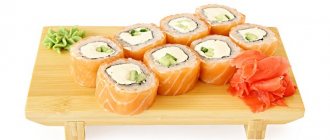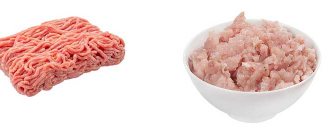Dietary properties of tuna:
In the seas of the tropics and subtropics there is a huge fish - tuna, which is one of the largest representatives of the mackerel family. The meat of this fish has truly extraordinary taste, for which culinary experts have dubbed it “veal of the sea.”
Many people are interested in the benefits of this fish and what calorie content tuna has. After all, this question cannot but interest those who monitor their body weight - after all, tuna is classified as a dietary product.
So, let's look at the beneficial and dietary properties that this fish has.
Researchers from the Netherlands have proven through experiments that regular inclusion of this fish in the diet (at least 30 grams per day), due to its high content of the Omega-3 fat complex, halves the likelihood of developing cardiovascular diseases. And this is only one of those valuable qualities that characterize this type of fish. It is a rich source of various microelements necessary for humans (for example, phosphorus, selenium, calcium, magnesium, iron), as well as vitamins and essential amino acids.
Eating this fish helps strengthen the immune system, helping the active synthesis of antibodies and reducing the risk of allergic reactions, it is useful for the rapid elimination of inflammatory processes, and can serve for the prevention of cancer. Tuna will also be useful for patients during treatment of cancer; it improves vision, protects us from depression and helps reduce pain from arthritis and arthrosis.
Regular inclusion of this fish meat in the diet “spurs up” metabolic processes in the body, normalizes blood sugar and helps eliminate cholesterol from the body. Thanks to its last feature, this fish is recommended for patients with hypertension and people suffering from excess body weight. In addition, this type of fish is very useful for restoring and normalizing the functions of human mucous membranes and skin (for example, for eczema).
For more than a decade, medicine has publicly declared that tuna fish, the beneficial properties of which can compete with many pharmaceuticals, is a natural medicine that successfully fights thrombophlebitis, cholecystitis and arrhythmia. It is recommended for use by people with weakened immune systems, inflammatory diseases and low hemoglobin levels. Regular use (once a week) will keep the heart and circulatory system healthy.
Melancholic people and people prone to depression can be advised to be treated not with chemicals, but with a natural product - tuna. Consumption of sea fish will save you from negative emotions, lift your spirits, and eliminate tension and stress. Omega-3 acids will improve blood flow, hormonal levels and the immune system. Tasty therapy can have a positive effect on your mental health.
It goes without saying that this fish also has its disadvantages. Undoubtedly, like any other product, tuna can bring both benefits and, unfortunately, harm, especially in canned form. Yes, and fresh fish can harm a woman’s body during pregnancy, during the lactation period, as well as in patients with kidney dysfunction. Those with allergies to fish fillets of the mackerel genus are also not recommended to eat tuna, as it can harm their body.
Harm is minimized if fish is consumed in small quantities daily. Tuna meat should not be given to children; it is introduced into the child’s menu starting from the age of 3.
The Scumbriev family can rightfully be proud of one of its most outstanding representatives - tuna, so valued by lovers of Japanese national cuisine.
The dangers of canned tuna
Fish is one of the common allergens; eating canned tuna can cause an allergic reaction.
When following diets that reduce the amount of protein in the diet, it is recommended to limit the consumption of seafood.
Canned food with butter is a very fatty and high-calorie product, so they should not be consumed if you have atherosclerosis, obesity, diseases of the pancreas and gall bladder. If you have these diseases, it is better to choose tuna canned in its own juice.
This product may also be harmful due to the accumulation of mercury in fish meat. The older and larger it is, the more of this substance accumulates in it. Of course, the amount of mercury that can accumulate in tuna is very small. However, some researchers do not recommend consuming it more than twice a week. They believe that if you eat fish more often, mercury may accumulate in the body in dangerous concentrations.
TV channel “Trust”, program “Do you want to live long?”, theme of the issue “Tuna. Beneficial features":
OTV, program “Morning”, story about how to choose canned tuna:
How many calories are in tuna?
The number of calories in this fish, as a rule, is quite surprising.
Calorie content of fresh tuna is:
101 kcal per 100 grams of product
Proteins, fats and carbohydrates (BJU) of fresh tuna per 100 grams:
Proteins - 23.0
Fats – 1.0
Carbohydrates – 0.0
This is quite a bit for tasty and healthy fish. The Japanese, for example, love it so much that all stores have a separate counter specifically for it.
But what calorie content does this fish have, depending on the method of preparation:
Tuna calorie table, per 100 grams of product:
| Product | Calories, in kcal |
| calorie content of boiled tuna | 140,0 |
| Grilled tuna calories | 150,0 |
| steamed tuna calories | 103,0 |
| calorie content of tuna in its own juice | 96,0 |
| calories in tuna oil | 190,0 |
| calorie content of smoked tuna | 139,0 |
| salted tuna calories | 139 |
| calorie content of baked tuna | 106,4 |
And the nutritional value of this fish, prepared in different ways, is this:
Tuna nutritional value table (BJU), per 100 grams of product:
| Tuna | Squirrels, gr. | Fats, gr. | Carbohydrates, gr. |
| boiled | 24 | 5,0 | 0,0 |
| Grilled | 20,0 | 5,1 | 0,0 |
| for a couple | 22,6 | 1,0 | 0,0 |
| in its own juice | 21,0 | 1,2 | 0,0 |
| In oil | 27,1 | 9,0 | 0,0 |
| smoked | 24,4 | 4,6 | 0,0 |
| salty | 24,5 | 4,5 | 0,0 |
| baked | 22,5 | 1,8 | 0,0 |
How to choose a quality product
Tuna is sold fresh, frozen or canned . The shelf life of fresh and frozen products is limited: fresh fillets are stored for no more than 4 days, frozen fillets are stored for up to 2 weeks.
Fresh tuna fillets are similar in color to beef. Questionable freshness is indicated by the uneven shade of the piece you like.
It's even worse if brownish spots are visible on it.
When choosing a packaged product, you need to carefully study the information on the packaging and the expiration date. The best time for such purchases is May-August.
Canned tuna is more accessible - in its own juice or in oil . Fish in its own juice retains more beneficial properties than fish canned in oil.
If we are talking about a dietary product, take into account that the addition of oil increases the calorie content of the product.
When choosing canned food, carefully inspect the packaging. Cans that are deformed, swollen, or with traces of rust do not deserve your attention.
Then study the markings and information on the label. The marking can be embossed from the inside or applied with permanent paint.
Fuzzy symbols and poor quality paint are indicative signs that the canned food is not of the best quality. The most reliable marking is a convex marking, since it is applied in production, and counterfeiting becomes impossible.
The first row of symbols indicates the assortment code; for tuna it will be the abbreviation GTN. The second row of symbols indicates the date of manufacture.
It is better to take a product released more than 3 months ago . During this time, canned tuna acquires a rich taste.
In addition, it makes sense to shake the jar and roughly assess the ratio of fish to liquid.
Canned tuna contains only fish meat, salt and vegetable oil if you choose canned food with added oil. Products in their own juice retain more beneficial properties and taste richer.
In addition, canning in oil has another pitfall - some manufacturers mix old and young fish, and the oil masks differences in taste.
There are also ethical restrictions. When choosing canned products, it is advisable to look for those that have the “dolphinfriendly” mark on the label.
This means that the fishing was carried out legally, without violating technology and did not lead to the death of dolphins.
Tips for choosing canned tuna:
Recipe? Recipe!
How to cook this fish at home? Here is one of the recipes:
Tuna in tomato:
Products:
- Tuna -1 kg.
- Onions - 2 pieces
- Tomatoes -1 kg.
- Garlic - 2 cloves
- Wine (white) – ½ glass
- Oil, salt and pepper - to taste
- Breadcrumbs, parsley - also to taste
The fish is cleaned of bones and skin, salted and peppered. Then roll in flour and fry. Separately, lightly fry the chopped onion and garlic (in olive oil), and then add the tomatoes and simmer everything together until a thick mass is obtained. The resulting mass is wiped in a colander, salt, sugar, wine and spices are added to it - to your taste. This will give us the sauce.
Place the finished sauce on a heat-resistant tray, place pieces of fried tuna on top of the sauce, sprinkle everything on top with breadcrumbs and parsley and place the tray in the oven until browned. The fish is served on the table in the same tray. That's all! Eat healthy!
What are the benefits of tuna for weight loss?
First of all, I would really like to note that eating tuna for dietary purposes is an excellent way to lose extra pounds without losing muscle mass. The fact is that in the process of losing weight it is very important not to completely lose fat in the diet, otherwise the body will not burn its own fat on the internal organs. Another thing is that during the diet you need to consume the right fats, which will stimulate the burning of internal excess reserves.
The pleasant taste and truly medicinal composition of tuna with its rather low calorie content allowed this fish to become, without exaggeration, the “king” of various weight loss programs. Nutritionists have developed many dishes for weight loss, which include tuna, both freshly prepared and canned, as an ingredient for salads and snacks.
Tuna goes best with fruit vegetables (tomatoes, cucumbers, bell peppers) and leafy vegetables (lettuce, iceberg, Chinese cabbage). An excellent addition to the salad can be onions, a stalk of celery, green peas, corn, basil sprigs and pine nuts.
One condition is that diet dishes should not be seasoned with mayonnaise, even low-calorie ones; it is best to sprinkle them with lemon juice and pour a little olive oil over them. Only with this approach to nutrition will your figure soon become slim, your skin will become elastic, and your nervous system will be in perfect order.
More on the same topic:
Comments (1)
- LaskaS Writes, First of all, I would like to note that eating tuna for dietary purposes is a good way to get rid of excess weight without losing muscle mass. The fact is that when losing weight, it is very important not to completely exclude fats from the diet. Otherwise, our body will not break down its own fat in internal organs. But while adhering to a diet, you should consume the “right” fats, which will help burn excess internal reserves.
Potential danger, contraindications
Any product that is consumed in moderation can cause harm. There are categories of people for whom tuna is not recommended or contraindicated .
These are pregnant women, nursing mothers and children under 3 years of age. Why is tuna harmful?
Since this fish accumulates mercury in its tissues , it is better to avoid eating it. If expectant mothers can occasionally enjoy this delicacy, small children are introduced to it only at 4 years of age.
High protein content may harm people with kidney disease . Dishes made from tuna meat are contraindicated in cases of severe renal failure. Restrictions may also be imposed for other kidney diseases.
The product is strictly prohibited for people with a severe allergy to sea fish , especially if they are intolerant to mackerel meat.
The “Live Healthy!” program will tell you how tuna can be dangerous:








